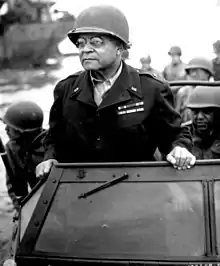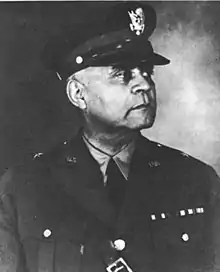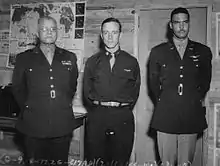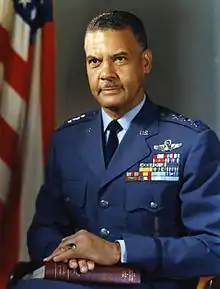Benjamin O. Davis Sr.
Benjamin Oliver Davis Sr. (July 1, 1877 – November 26, 1970) was a United States Army officer. In 1940, he became the first African-American to rise to the rank of brigadier general. He was the father of Air Force Brigadier General Benjamin O. Davis Jr.. According to historian Russell Weigley, his career is significant not for his personal accomplishments, because he was only allowed a limited range of responsibilities, but as an indicator of a small forward movement for blacks in the American army in the World War II era. The New Deal era of Franklin Roosevelt was favorable toward blacks, and in 1940 he appointed Davis as the first black general. During World War II, Davis held troubleshooting staff assignments designed to assist the expanded role of blacks, albeit in segregated units. He did not have command of troops.[1]
Benjamin Oliver Davis Sr. | |
|---|---|
 Davis in France on August 8, 1944 | |
| Born | May 1880 (per census document) July 1, 1877 (official) Washington, D.C., United States |
| Died | November 26, 1970 Aged 90 (per census document) Aged 93 (official) Chicago, Illinois, United States |
| Place of burial | Arlington National Cemetery, United States |
| Allegiance | |
| Service/ | |
| Years of service | 1898–1948 |
| Rank | |
| Unit | 9th Cavalry |
| Commands held | 369th Infantry Regiment 4th Cavalry Brigade |
| Battles/wars | Spanish–American War Philippine–American War World War I World War II |
| Awards | Distinguished Service Medal Bronze Star French Croix de Guerre Africa Star |
| Relations | Son – Gen. Benjamin O. Davis Jr., USAF |
Early life and education
Davis was born in Washington, D.C., the third child of Louis P. H. Davis and Henrietta (née Stewart) Davis. Biographer Marvin Fletcher has presented evidence that Davis was born in May 1880, citing a June 1880 census document.[2][3] Fletcher concludes that Davis lied about his age so that he could enlist in the Army without the permission of his parents. The birth date that appears on Davis's gravestone at Arlington National Cemetery is July 1, 1877, the date he provided to the Army.
Davis attended M Street High School in Washington, where he participated in the school's cadet program. During his senior year of high school he took some classes at Howard University. His father, a messenger for the Interior Department, and his mother, a nurse, urged him to enroll in college after high school. Against his parents' wishes, he determined to pursue a military career.[4]
Career
After graduating from high school, in response to the start of the Spanish–American War, Davis entered the military service on July 13, 1898, as a temporary first lieutenant in the 8th United States Volunteer Infantry, an all-African-American unit. This regiment was stationed at Chickamauga Park, Georgia, from October 1898 until the unit was disbanded in March 1899. During the war, Davis briefly served in Company D, 1st Separate Battalion of the Washington D.C. National Guard.
Davis was mustered out on March 6, 1899, and on June 18, 1899, he enlisted as a private in Troop I, 9th Cavalry Regiment (one of the original Buffalo Soldier regiments), of the Regular Army. At his post in Fort Duchesne, Utah, he served first as the troop's clerk and later as squadron sergeant major through 1900. In late 1900, Davis's unit was commanded by Lieutenant Charles Young, the only African-American officer serving in the US military at that time.[4] Young encouraged Davis's ambition to become an officer. Young tutored Davis in all of the subjects that were covered in the officer candidate test, especially mathematics, which had been the most difficult subject Young had encountered at the United States Military Academy at West Point. In early 1901 Davis passed the test at Fort Leavenworth, Kansas, his highest score coming in the math section.[5] (A second African American, John E. Green, passed the test along with 10 other soldiers.[4]) On February 2, 1901, Davis was commissioned a second lieutenant of Cavalry in the Regular Army.
In the spring of 1901, Troop I was posted overseas to serve in the Philippine–American War. In August 1901, Davis was assigned to Troop F, 10th Cavalry, where he assumed the duties of a second lieutenant. Troop F returned to the US in August 1902. Davis was then stationed at Fort Washakie, Wyoming, where he also served for several months with Troop M. In September 1905, he was assigned to the traditionally Black Wilberforce College in Ohio as Professor of Military Science and Tactics, a post that he filled for four years.
In November 1909, shortly after being ordered to Regimental Headquarters, 9th Cavalry, Davis was reassigned for duty to Liberia. He left the United States for Liberia in April 1910, and served as a military attaché reporting on Liberia's military forces until October 1911. He returned to the United States in November 1911. In January 1912, Davis was assigned to Troop I, 9th Cavalry, stationed at Fort D. A. Russell, Wyoming. In 1913, the 9th Cavalry was assigned to patrol the Mexican-United States border.
In February 1915, Davis was again assigned to Wilberforce College as Professor of Military Science and Tactics. From 1917 to 1920, Davis was assigned to the 9th Cavalry at Fort Stotsenburg, Philippine Islands, as supply officer, commander of the 3rd Squadron, and then of the 1st Squadron. He reached the temporary rank of lieutenant colonel but returned to the United States in March 1920 with the rank of captain.
Davis was assigned to the traditionally Black Tuskegee Institute (now Tuskegee University) in Tuskegee, Alabama, as the professor of military science and tactics from 1920 to 1924. He then served for five years as an instructor with 2nd Battalion, 372nd Regiment, Ohio National Guard, in Cleveland, Ohio. In September 1929, Davis returned to Wilberforce as a professor of military science and tactics. He was assigned to the Tuskegee Institute in the early part of 1931 and remained there for six years as a professor of military science and tactics. During the summer months of 1930 to 1933, Davis escorted pilgrimages of World War I Gold Star mothers and widows to the burial places of their loved ones in Europe.
In August 1937, Davis returned to Wilberforce University as a professor of military science and tactics. Davis was assigned to the 369th Regiment, New York National Guard, during the summer of 1938, and took command of the regiment a short time later. Davis was promoted to brigadier general on October 25, 1940, becoming the first African-American general officer in the United States Army.[6]

World War II

Davis became commanding general of the 4th Cavalry Brigade, 2nd Cavalry Division at Fort Riley, Kansas, in January 1941. About six months later, he was assigned to Washington, D.C. as an assistant in the Office of the Inspector General. While serving in the Office of the Inspector General, Davis also served on the Advisory Committee on Negro Troop Policies. From 1941 to 1944, Davis conducted inspection tours of African-American soldiers in the United States Army. From September to November 1942 and again from July to November 1944, Davis made inspection tours of African-American soldiers stationed in Europe.
On November 10, 1944, Davis was reassigned to work under Lieutenant General John C. H. Lee as special assistant to the commanding general, Communications Zone, European Theater of Operations. He served with the General Inspectorate Section, European Theater of Operation (later the Office of the Inspector General on Europe) from January through May 1945. While serving in the European Theater of Operations, Davis was influential in the proposed policy of integration using replacement units.
Later life and death
After serving in the European Theater of Operations for more than a year, Davis returned to Washington, D.C. as an assistant to the Inspector General. In 1947 he was assigned as a special assistant to the Secretary of the Army. In this capacity, he was again sent to Liberia in July 1947 as a representative of the United States for the African country's centennial celebration.
On July 20, 1948, after fifty years of military service, Davis retired in a public ceremony with President Harry S. Truman presiding. 6 days later on July 26, 1948, President Truman issued Executive Order 9981 which abolished racial discrimination in the United States armed forces.
From July 1953 through June 1961, Davis served as a member of the American Battle Monuments Commission.
Davis died on November 26, 1970, at Great Lakes Naval Hospital in Chicago, Illinois, and was buried with his wife Sade Overton at Arlington National Cemetery.[7]
Legacy
In 1997, the U.S. Postal Service issued a 32-cent stamp honoring Davis.[8]
Personal life

Davis married Elnora Dickerson in 1902—the two had known each other as neighbors for many years. Their first child was born in 1905, daughter Olive Davis. A son was born in 1912, Benjamin O. Davis Jr. In early 1916, a second daughter was born, but Davis's wife died a few days later from complications of childbirth. The daughter, Elnora Davis, was named for her. Without a mother for the children, Davis relied upon the child's grandparents in Washington, D.C. for childcare while he was serving a tour of duty in the Philippines.[4] In 1919 Davis married Sarah "Sadie" Overton, an English teacher at Wilberforce University.[9] They were married for 47 years, the partnership ending at Sadie's death on October 25, 1966.[10]
Davis's son became the first black general officer of the United States Air Force in October 1954.[10]
Awards and honors
United States military awards
- Distinguished Service Medal
- Bronze Star Medal
- Spanish War Service Medal
- Philippine Campaign Medal
- Mexican Border Service Medal
- World War I Victory Medal
- American Defense Service Medal
- American Campaign Medal
- European-African-Middle Eastern Campaign Medal
- World War II Victory Medal
- Army of Occupation Medal
Foreign awards
- Commander of the Order of the Star of Africa (Liberia)
- Croix de Guerre with Palm (France)
Distinguished Service Medal citation
General Davis was awarded the Distinguished Service Medal (DSM) by General Order 10, dated February 22, 1945. The War Department press release about General Davis' DSM issued on February 11, 1945, included the following citation:
- For exceptionally meritorious service to the Government in a duty of great responsibility from June 1941, to November 1944, as an Inspector of troop units in the field, and as special War Department consultant on matters pertaining to Negro troops. The initiative, intelligence and sympathetic understanding displayed by him in conducting countless investigations concerning individual soldiers, troop units, and components of the War Department brought about a fair and equitable solution to many important problems which have since become the basis of far-reaching War Department policy. His wise advice and counsel have made a direct contribution to the maintenance of soldier morale and troop discipline and has been of material assistance to the War Department and to responsible commanders in the field of understanding personnel matters as they pertain to the individual soldier.
Other honors
In 1943 General Davis was awarded the honorary degree of LL.D. (Doctor of Laws) from Atlanta University in Atlanta, Georgia.
Dates of rank
| First lieutenant, United States Volunteers: July 13, 1898 | |
| No insignia | Private, 9th Cavalry: June 14, 1899 |
 |
Corporal, 9th Cavalry: circa 1899 |
| Squadron Sergeant Major, 9th Cavalry: circa 1900 | |
| No pin insignia in 1901 | Second Lieutenant, Regular Army : February 2, 1901 |
| First Lieutenant, Regular Army: March 30, 1905 | |
| Captain, Regular Army: December 24, 1915 | |
| Major, National Army: August 5, 1917 | |
| Lieutenant colonel, National Army: May 1, 1918 | |
| Captain, Regular Army: October 14, 1919 | |
| Lieutenant colonel, Regular Army: July 1, 1920 | |
| Colonel, Regular Army: February 18, 1930 | |
| Brigadier General, Army of the United States: October 25, 1940 | |
| Brigadier General, Retired List: July 31, 1941 |
See also
- List of African American firsts
References
- Weigley, 1974.
- Fletcher, Marvin E. (1989). America's First Black General: Benjamin O. Davis, Sr., 1880–1970. Lawrence, Kansas: University of Kansas.
- June 4, 1880, US Census page showing Benjamin Davis to be one month old.
- Henry Louis Gates Jr; Evelyn Brooks Higginbotham, eds. (2004). African American Lives. Oxford University Press. p. 211. ISBN 019516024X.
- Kilroy, David P. (2003). For Race and Country: The Life and Career of Colonel Charles Young. Greenwood. pp. 48–50. ISBN 0275980057.
- "Chapter III: The Negro Positions Defined". history.army.mil. Retrieved November 15, 2019.
- Burial Detail: Davis, Benjamin O (Section 2, Grave E-478-B) – ANC Explorer
- "Stamp Series". United States Postal Service. Archived from the original on August 10, 2013. Retrieved September 2, 2013.
- Coffman, Edward M. (2007). The Regulars: The American Army, 1898–1941. Harvard University Press. pp. 92–93. ISBN 978-0674024021.
- Silbermann, Paul (2002). "Benjamin O. Davis, Jr. Collection" (PDF). National Air and Space Archives. Smithsonian Institution. pp. 1–2. Retrieved November 6, 2012.
- Official Register of Commissioned Officers of the United States Army. 1948. Vol. 2. p. 2152.
Further reading
- "Benjamin Oliver Davis Sr. – The First African American General Officer in the Regular Army and in the U.S. Armed Forces". United States Army Center of Military History. Archived from the original on June 29, 2007.
- Kranz, Rachel, and Philip Koslow, eds. Biographical Dictionary of African Americans (Facts on File, 1999)
- Lee, Ulysses (1966). The Employment of Negro Troops. reprints 1986, 1990. Washington, D.C.: United States Army Center of Military History.
- Jones, Jeffery. "Benjamin O. Davis Sr., America's First Black General: The Paradox of Racial Leadership and the Military Profession." (PhD Dissertation, University of Memphis, 2019) excerpt.
- Weigley, Russell F. "Davis, Benjamin Oliver, Sr." in John A. Garraty, ed. Encyclopedia of American Biography (1974) pp. 256–257.
External links
- General Ben Davis: An Inspiration To All, US Army
- Benjamin O. Davis Sr. Collection US Army Heritage & Education Center, Carlisle, Pennsylvania
- Benjamin O. Davis Sr. at Find a Grave
